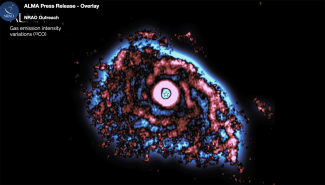Two theories of planet formation have long-dominated astronomy - the first theory, “core accretion,” posits that planets grow slowly from particles of dust ultimately forming pebbles, then boulders, which coalesce to form planets over tens of millions of years.
The second theory – “gravitational instability,” in which planets form quickly from direct collapse of gas and dust, requiring hundreds to thousands of years instead – received new support in a study published in the journal Nature today:
In a powerful match-up of technique, instrumentation, and target, an international team of astronomers led by Jessica Speedie, Department of Physics & Astronomy PhD candidate at the University of Victoria (Canada), observed the well-characterized protoplanetary disk around AB Aurigae and found observational evidence that matches the alternative “top-down” theoretical sequence of planet formation.
The U.S. National Science Foundation National Radio Astronomy Observatory (NSF NRAO) and the Atacama Large Millimeter/submillimeter Array (ALMA), in which NRAO is a partner, were crucial to the team’s success. “ALMA’s sensitivity and high velocity resolution enabled us to probe the gas deep within the disk and measure its motion precisely. It was the only tool for the job,” Speedie says.
Astronomers have already spotted several developing protoplanets currently forming in AB Aurigae’s disk region, including one that is nine times more massive than Jupiter. They appear as clumps nestled within a clear structure of spiral arms rotating counterclockwise around the star. The star itself, AB Aurigae, has a mass of approximately 2.4 times that of our Sun, and is roughly 4 million years old. The star’s age implies a conundrum: if the “bottom-up” process has not had time to take place, then by what mechanism are the protoplanets forming?
Speedie, her PhD advisor Ruobing Dong, and their team set out to use ALMA to study how the gas in the system’s vast spiral arms is moving. “Disks that are gravitationally unstable should have distinctive ‘wiggles’ in their velocity field, unlike disks that are stable,’’ says Dr. Cassandra Hall, Assistant Professor of Computational Astrophysics at the University of Georgia and co-author on the research. “Back in 2020, we performed some of the most advanced simulations in the world to predict the existence of this hallmark signature of gravitational instability,” Hall said of the research she led four years ago. “It was clear, it was testable, and it was a bit scary – if we didn’t find it, then something had to be very, very wrong with our understanding of these disks.”
According to Hall, the two theories have battled it out in astronomy for a while, with core accretion being very strongly preferred. Most astronomers think that gravitational instability does not form planets.
"However, our work is the first conclusive detection of gravitational instability, and we have found it in a disk that is already known to have baby planets in it - they are too young to have formed through core accretion, and so the most logical conclusion is that they formed through gravitational instability," she said.
The full article, "Gravitational instability in a planet-forming disk," was published September 4.
Image: ALMA images reveal vast spiral arms in the AB Aurigae circumstellar disk. Credit: ALMA (ESO/NAOJ/NSF NRAO), VLT/SPHERE (ESO), Speedie et al.

